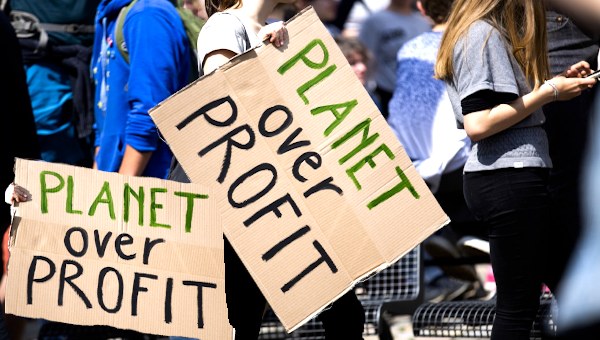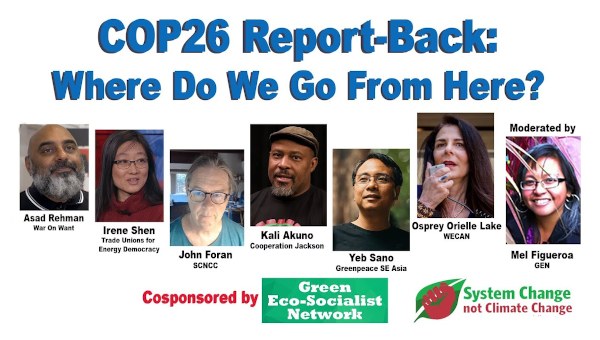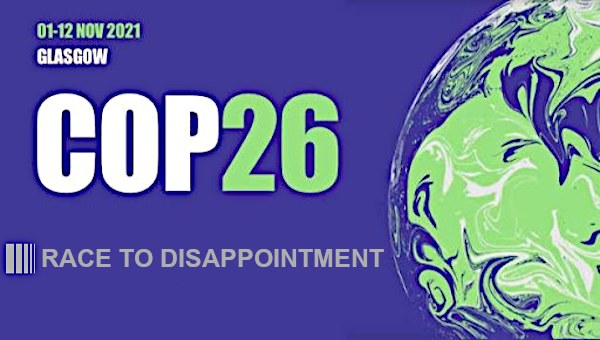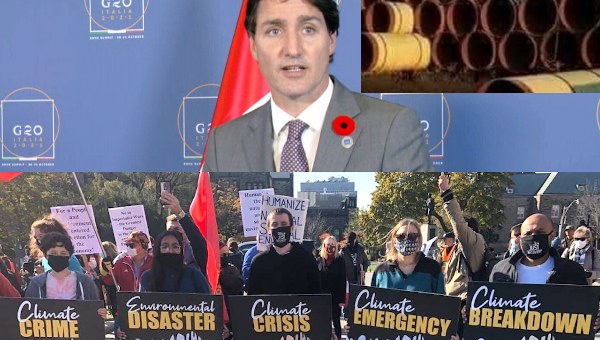COP26: Dangerous Omissions, Amplifying Feedbacks, Human Fatalities
November 2021 saw the 26th meeting of the Conference of the Parties (COP26). This year the meeting was held in Glasgow. The COP is the global governing body made up of all the countries signatory to the Kyoto Protocol climate treaty. Thirty-three years ago, in 1988, climate scientist James Hansen and other climate scientists testified to both a US Congressional Committee and a Senate Panel. They presented conclusive evidence of anthropogenic (human caused) climate change and warned that “planning must begin now for a sharp reduction in the burning of coal, oil and other fossil fuels that release carbon dioxide.” In his later research based on Earth’s paleoclimate record, Hansen determined that the tipping point marking the shift to an ice-free planet was when the concentration of atmospheric greenhouse gases reached approximately 350 parts per million (ppm) of CO2 or of CO2 equivalents (the other major heat-trapping gases are methane, nitrous oxide, and water vapor).
The negotiations and pledges to reduce greenhouse gas (GHG) emissions rely on three categories: the quantity of CO2 released into the atmosphere, mainly from fossil fuels; the quantity of greenhouse gases at an arbitrary baseline, and the target date for reducing greenhouse gases; and the percentile amount of reductions by the target dates. For example, the US has pledged to reduce GHG emissions 50% below 2005 levels by 2030, and to reach net zero emissions by 2050. Net zero means equalizing what is added and what is subtracted. The goal is to cap temperature rise at 1.5°C above pre-industrial levels.
The most critical facts are missing in these equations. Omitting amplifying feedbacks and greenhouse gas concentration means that all the predictions of temperature rise and the computations about carbon budgets are simply wrong. Omitting human fatalities, to say the least, is pastel-washing the climate disaster and omitting the already disastrous human fatalities at a temperature rise at 1°C of warming. Climate scientists like James Hansen have long warned that any increase above 1°C is catastrophic for humanity. The target temperatures and target budgets are political decisions challenged by scientific facts.
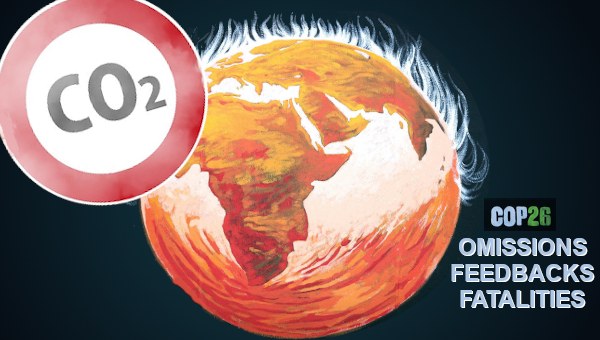
The Science
To use the words of Joel Schlosser in his book Herodotus and the Anthropocene, the climate is a system of “dynamic complexity,” of many interactions, some of which were unpredictable and are still being identified as they emerge with climate changes.1
Hansen clearly explained the basic facts to the public in his 2009 book Storms of My Grandchildren: the truth about the coming climate catastrophe and our last chance to save humanity.2 First, science has indicated that steep reductions should have been implemented immediately to prevent positive feedbacks that would eventually cascade global heating to levels beyond human control. By 1988, enough CO2 had been emitted by fossil fuels to increase heat-trapping to a dangerous level. As is well known, English industrial production was built on coal. By the early 19th century, living conditions in England dramatically deteriorated as industrial production inflicted horrific health consequences on labourers, chillingly described by Engels.3 In fact, England’s success in reorganizing the global economy was at the cost of the resultant massive numbers of human fatalities and extensive environmental ruin. Andreas Malm documents how other equally good energy options existed at the beginning of the industrial revolution, but entrepreneurial ambition and deceit undermined these alternatives.4
At present, industrial production in all sectors, including mechanized mono-crop agriculture, still relies on fossil fuels. It is largely unquestioned that production is essential in most sectors, essential for GDP and for private profit, and that industrialization and the market economy (which in itself is a high emitter because of its data centers) can continue as-is until fossil fuels can simply be replaced by renewables.
In his book, Hansen writes that nature itself, before humans inhabited the Earth, changed the level of carbon dioxide in the atmosphere, moving the earth in and out of ice ages and extinctions, but these changes were at an entirely different time scale than the exceedingly rapid changes of the past 200 years. Previous large shifts in the amount of CO2 in the atmosphere took hundreds of thousands of years. One ten thousandth of 1 ppm/year created an energy imbalance by 100 ppm of CO2 over a million-year period, resulting in a huge change. Compare this to the current, unprecedented rate of CO2 buildup. At this time, the amount of CO2 concentration increased in both 2015 and in 2016 by 2.9 ppm in just one year.
The past 25 COP meetings have postponed or ignored this accelerated pace of emissions. To repeat, Hansen explained that any further addition above 350 ppm increases the global temperature to the level at which Earth will eventually be ice-free, leading to sea-level rises of 75 meters. The paleoclimate record correlates greenhouse gas concentration, global average surface temperature, and the rapidity of climate changes. The record shows that in the past, sea levels did increase by several meters a century. The IPCC lower predictions of sea level rise were based on models that left out melting ice from the Arctic and Antarctic. (Hansen p. 81). Even a temperature rise of less than 1°C has already caused some salt-water infiltration of major food-growing areas like the Mekong and Nile deltas and there are now predictions that the populations of island countries and coastal cities, will need to be re-located this century.
Amplifying Feedbacks
Amplifying feedbacks accelerate the rise of temperature. During the Holocene era, with its ideal climatic conditions for human life, nature itself ensured a balance between incoming and outgoing solar radiation. In the Anthropocene, that balance has altered by increasing the amount of CO2 in the atmosphere, resulting secondarily in feedbacks that destroy nature’s ways of absorbing CO2. Crucial are the carbon “sinks”: forests, soil, and ocean intake of CO2. ‘Smoke and mirrors’ describes both an amplifying feedback and deceptive climate politics. Forest fires are a double amplifying feedback as they add to atmospheric CO2 by destroying this natural carbon sink and by causing a lower albedo effect, which results in an increase in the absorption of harmful solar radiation as the black soot covers Arctic ice. The black surface absorbs heat instead of the white surface mirroring solar radiation back into space.
Human Fatalities
The words ‘human deaths’ are not used in describing climate impacts. Instead, it seems that people are spoken of by leaders as inanimate, as collateral damage or as elements, and the brain is a mass of electrical circuits; and artificial intelligence will be more helpful than human understanding. Graphs, charts, statistics inform about all sorts of climate impacts, abstractions about the fate of the planet, societies, the economy.
An attempt was made to account for human fatalities in Kofi Annan’s 2009 The Global Humanitarian Forum, reporting at the time of the Copenhagen COP meeting that 300,000 people were dying each year due to climate change. Soon after, the organization lost its funding. The WHO/UNEP now reports 150,000 deaths annually, and a paper published this year in The Lancet reports 5 million climate-related deaths a year. It is hard to know which figures to trust. A new method to more accurately determine mortality, the World Mortality Database, found that the number of people dying in the 2015 Egyptian heat wave was 20,000, not 61.
Human fatalities were front-and-center for Nnimmo Bassey, executive director of Friends of the Earth International and of Environmental Rights Action Nigeria. He said of 2011 COP in Durban: “This is a death sentence for Africa.” Filipino delegate Yeb Sano at the 2012 COP meeting, which took place when typhoon Haiyan killed 500 people with hundreds missing, spoke to the delegates: “Please… let 2012 be remembered as the year the world found the courage to… take responsibility for the future we want. I ask of all of us here, if not us, then who? If not now, then when? If not here, then where?”
What we do know is that untold numbers of fatalities are due directly to climate disasters. There are many other indirect victims: in oil wars, in the killing of land defenders, in the child deaths due to smoke inhalation from tropical forests burnt to make way for biofuel plantations.
The COP was established after a series of UN environmental meetings, beginning in 1972 that culminated in the 1992 Rio Earth Summit and the 1994 UN Framework Convention on Climate Change. Eric Toussaint, a founding member of the Committee for the Abolition of Third World Debt (CADTM), reports fascinating details about the management of the Global Environment Facility regarding “the amounts of monetary sums related to the implementation of Agenda 21” an international program of action for achieving sustainable development during the 21st century, adopted at the Earth Summit. The World Bank secured this role by concealing a report about the number of people who would be displaced by the Narmada Dam which the Bank was funding.5
Patrick Bond, professor of political economy in South Africa, renames COP as Conference of Polluters and Conference of Paralysis. He has written about the 2011 Durban COP and has just reported on the deceptions of technological and market fixes at COP26. He has long researched carbon trade and institutionalized environmental racism.6
COP26 Proposed Timelines
The proposal of net zero emissions only considers baseline and target dates, gigatons of CO2, and percentile reductions. The calculations do not consider the concentration of greenhouse gases in the atmosphere or the feedbacks that they generate. The feedbacks in 2021 are much greater than the feedbacks of a decade ago. The greater the concentration of GHG, and they are increasing at a more rapid rate, then the greater their effect. The CO2 equivalents like methane, nitrous oxide, and water vapor, have also vastly increased over pre-industrial levels. As reported by the National Oceanic and Atmospheric Administration, NOAA in 2019, the actual GHG concentration, including CO2 equivalents (methane, nitrous oxide), was 500 ppm – far above the 350 parts per million at which the Earth shifts to an ice-free state. This means more rapid increases in temperatures over land and in water, more rapid ice melt, and greater sea-level rise.
The timing of when and how measures to reduce emissions are implemented is crucial because of amplifying feedbacks and greenhouse gas concentration in the atmosphere. Scientists warn that feedbacks are unpredictable and their interactions lead to cascading chain reactions. Emitted gases interact within a complex system with varying time scales: a slight rise in temperature is much more dangerous when forests have already dried up because of multi-year droughts. Slight increases in temperature now cause more intense and frequent forest fires, while in the past a slight increase in temperature did not have this effect. Delaying substantial reductions gambles with ‘runaway’, uncontrollable climate change.
Meanwhile, the net zero pledges at COP26 do not explain why the specific dates and amounts of reductions were selected. What was the temperature, the amount of GHG in the atmosphere, or the kinds of feedbacks already unleashed at the baseline dates? There are many unanswered questions. Do the reductions include the three exempt sectors – international aviation, international shipping, and the military? Do the national pledges include outsourced emissions?
The pledges are all over the map and are still changing. Biden pledged to reduce emissions 50% by 2030 and achieve zero emissions by 2050 from a baseline of 2005, but 2005 was the year that US emissions peaked at just below 6,000 million tonnes of CO2. US emissions in 2019 were 13% lower than in 2005, after accounting for sequestration by the land sector (soil is a carbon sink). Choosing a baseline from the highest year allows less stringent reductions. Putin committed Russia to a target of net zero by 2060 – the same as China and, most recently, Saudi Arabia. India pledged net zero by 2070. The International Maritime Organization pledged a cut of 50% from 2008 levels, but the shipping sector doesn’t yet have technology to reach net zero by 2050. Canada’s target is 40 to 45% reduction below 2005 levels by 2030 and zero by 2050.
But how real are these pledges? The Canadian government speaks through both sides of its mouth because it continues to provide massive fossil fuel subsidies, supporting pipelines and tar sands development even though, as Hansen has said, development of the tar sands would mean “game over for the planet.” Similarly, the EU pledged in June to cut 55% in net greenhouse gas emissions by 2030, compared with 1990 levels, and zero net emissions by 2050, but continues to substantially outsource industrial production.
Radical Proposals
Since the US scientists’ 1988 deposition mentioned at the start of this essay, no schedule or clear timetable of mandatory reductions, firm regulations, or enforced implementation has been developed. In the face of climate change, a clear determination must be established, designating jurisdictional boundaries regarding decision-making and responsibility for providing basic necessities at the relevant levels of neighborhood, rural and urban, national, regional, and global communities.
With this emergency that has already caused massive human fatalities, there are ways to save people: an immediate cessation of coal, oil, and natural gas extraction, a moratorium on all non-essential industrial production and mining including a moratorium on construction with steal and cement, shifting the industrial labour sector to essential production in agriculture and ecosystem restoration and essential infrastructure maintenance, dismantling of the military, a rapid transition to agroecology and local distribution networks of food and other life necessities, a shift to free public transport and cessation of car manufacturing, a global equal wage, a cap on wealth and ownership above which money is unusable. •
Endnotes
- Joel Alden Schlosser, Herodotus in the Anthropocene, Chicago: University of Chicago Press, 2020. Schlosser uses the term “dynamic complexity” to conceptualize multiple and changing functions and interactions, applicable to understanding the climate and democracy.
- James Hansen, Storms of My Grandchildren: The truth about the coming climate catastrophe and our last chance to save humanity, New York: Bloomsbury, 2009. See especially pp. 140-71.
- Friedrich Engels, The Condition of the Working Class in England, Oxford University Press: Oxford, 1993.
- Andreas Malm, Fossil Capital: The rise of steam power and the roots of global warming, London: Verso, 2016.
- Eric Toussaint, The World Bank: A critical primer, London: Pluto Press, 2008. p. 183.
- Patrick Bond, Rahana Dada and Graham Erion, Climate change, Carbon Trading and Civil Society: Negative returns on South African investments, Scotsville, SA: University of KwaZulu-Natal Press, 2009.


